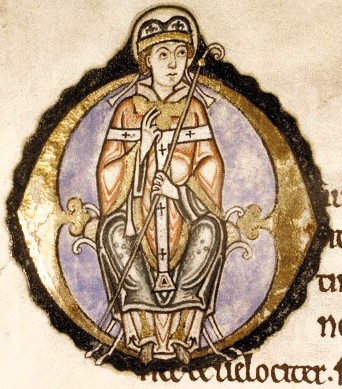
It shouldn’t be a source of surprise, though it often is, that an Archbishop of Canterbury might offer colourful and dramatic material to the novelist. The events surrounding King William’s choice of Anselm to fill that role, are colourful and dramatic in a particular way, being at the same time deeply serious and slightly ridiculous. Even the docile prose of Eadmer (his servant, friend and biographer) can’t disguise the strange, indecorous goings-on around the king’s sickbed in March 1093.
This is what the monk, Eadmer, an eyewitness, writes:
King William was stricken with a serious illness and came to the point of death. His barons persuaded him . . . to take thought for the church of Canterbury. He acquiesced in this advice and declared that Anselm was the man most fitted for this work. When Anselm heard this he wore himself half to death in his objections . . . in resisting and fighting against it. So he was seized and forcibly carried into the neighbouring church with hymns and rejoicings. This took place on 6th March 1093.
‘Seized and forcibly carried’? Isn’t this an assault? And this is happening in the presence of a dying king! What is going on here? Even Eadmer cannot quite disguise the comedy of the scene.
Open up his quiet prose and there, inside it, is another story altogether. Eadmer is trying to present Anselm as a man who didn’t want the job and had to be dragged ‘kicking and screaming’ into the archbishopric. Anselm’s objections are overcome by force. By literalising the metaphor Eadmer lets us know that Anselm is a modest and humble man, a scholar to whom worldly advancement is nothing and Christian humility is everything, someone who has no desire for what today we might call ‘celebrity’. This, I believe, is the picture of his master that Eadmer intends to give the world.
So I would like to pay tribute to Eadmer’s wonderful book which gives Anselm’s career lasting fame, but also (and perhaps unintentionally) lets light into dark places. We all like to keep them hidden, those dark places, the recesses where we hide our flaws, foibles and inconsistencies, our little games with truth, our distortions and falsities, our wilful penchant for ‘viewing askance’. Those things too languid to be sins, not sharp enough to be virtues. Eadmer lets in the light on these, both in himself and in his master.
Eadmer’s book is called The Life of Saint Anselm (Vita Sancti Anselmi, translated by R.W. Southern, Thomas Nelson & Sons, Edinburgh, 1962).
In following Anselm’s activities in The Remarkable Tale Of The Bull And The Sheep from his election in 1093, through his life in exile, and his relations with William Rufus during the entire period of his controversial episcopacy, I have drawn freely on Eadmer’s eyewitness account in the Vita Sancti Anselmi. Invaluable for facts and dates and so on, it also encourages a spirit of reading between the lines. The Life of Saint Anselm is rich with evasive meanings, giving a nebulous sense of actual occurrence confused with other-worldly revelation. This, I believe, is the territory of historical fiction which is itself probably better thought of as imaginative realism. No holds barred here – if Eadmer presents himself as an eyewitness, he must be prepared to be cross-examined. This is what I try to do in the novel.
I believe the novel form, particularly the historical novel, is about liberating facts from scholarship and setting them into a life story that is a great deal more than facts. By using this form, I wanted to convey something of the respect and affection I developed for Anselm in researching this book and its sequel. Among the great personalities of the time, I found Anselm to be an indefatigable source of spiritual energy who had a natural sympathy with the creatures who appear so often in his parables, a man of conscience, a flawed man, a dilatory and weary man, a man full of goodness and insecurities. It was all beautifully stated by Anselm himself in the metaphor from which the title of the book derives and which appears as an epigraph:
“You are trying to harness together at the plough under one yoke an untamed bull and an old and feeble sheep. What will come of it?”
The ‘bull’ being William Rufus and the ‘old and feeble sheep’ being Anselm. This was the inspiration for the book and the way into my researches. I warmed greatly to the self-derogatory humour and humility of this image.
Without Eadmer and his book this image might never have come down to us.